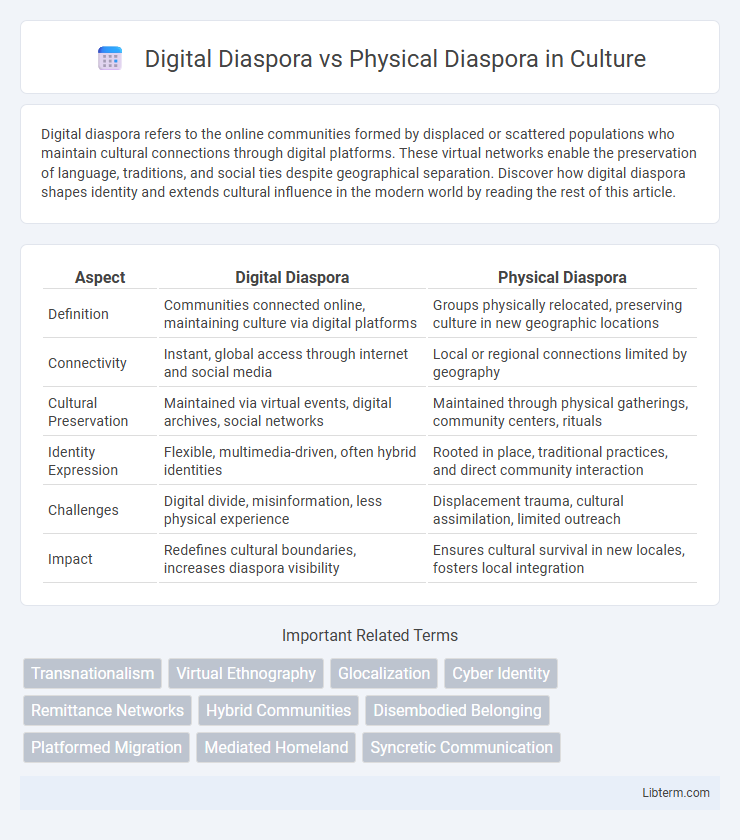Digital diaspora refers to the online communities formed by displaced or scattered populations who maintain cultural connections through digital platforms. These virtual networks enable the preservation of language, traditions, and social ties despite geographical separation. Discover how digital diaspora shapes identity and extends cultural influence in the modern world by reading the rest of this article.
Table of Comparison
| Aspect | Digital Diaspora | Physical Diaspora |
|---|---|---|
| Definition | Communities connected online, maintaining culture via digital platforms | Groups physically relocated, preserving culture in new geographic locations |
| Connectivity | Instant, global access through internet and social media | Local or regional connections limited by geography |
| Cultural Preservation | Maintained via virtual events, digital archives, social networks | Maintained through physical gatherings, community centers, rituals |
| Identity Expression | Flexible, multimedia-driven, often hybrid identities | Rooted in place, traditional practices, and direct community interaction |
| Challenges | Digital divide, misinformation, less physical experience | Displacement trauma, cultural assimilation, limited outreach |
| Impact | Redefines cultural boundaries, increases diaspora visibility | Ensures cultural survival in new locales, fosters local integration |
Understanding Diaspora: Digital vs Physical
Digital diaspora communities leverage online platforms and social media to maintain cultural connections across geographies, enabling real-time interaction and resource sharing among dispersed populations. Physical diaspora involves traditional migration and settlement patterns, characterized by the establishment of localized ethnic enclaves and face-to-face cultural exchanges within host countries. Understanding the distinction highlights how digital technologies expand diaspora engagement beyond physical boundaries, fostering transnational identity and collective memory through virtual networks.
Defining Digital Diaspora and Its Evolution
Digital diaspora refers to dispersed communities connected through digital platforms, transcending physical boundaries to maintain cultural identity and social ties. This evolution stems from advancements in internet technology and social media, enabling real-time communication and collective identity formation across global networks. Unlike physical diaspora, digital diaspora emphasizes virtual interaction and cultural exchange without geographic constraints.
Characteristics of Physical Diaspora Communities
Physical diaspora communities are characterized by their tangible presence in specific geographic locations, often maintaining strong cultural, social, and economic ties to their country of origin. These communities typically exhibit visible cultural markers such as language, traditional customs, and institutions like cultural centers or places of worship. They also face challenges related to integration, identity preservation, and intergenerational cultural transmission within host societies.
Communication Patterns: Online Platforms vs Face-to-Face Interactions
Digital diaspora relies heavily on online platforms such as social media, messaging apps, and virtual communities to maintain cultural ties and share information across geographic boundaries. Face-to-face interactions within physical diaspora enable deeper emotional connections and nonverbal communication, fostering stronger community bonds through shared physical presence. Online communication patterns emphasize instant connectivity and broad reach, while physical diaspora interactions prioritize intimacy and contextual cultural exchanges.
Cultural Preservation in the Digital Realm
Digital diaspora communities leverage online platforms to preserve cultural heritage by sharing language, traditions, and rituals through virtual spaces, fostering transnational connections and collective memory. These digital networks enable real-time cultural exchange and archival, reducing geographic and temporal barriers faced by physical diaspora groups. Through multimedia content, social media, and virtual events, digital diasporas maintain dynamic cultural identities while adapting to contemporary technological environments.
Identity Formation and Belonging in Both Diasporas
Digital diaspora facilitates identity formation through virtual communities, enabling individuals to maintain cultural connections and express belonging despite geographical distance. Physical diaspora, rooted in lived experiences and shared physical spaces, fosters identity through direct social interactions and cultural practices. Both diasporas shape belonging by providing platforms for cultural affirmation, yet digital diaspora offers fluid, transnational identity dynamics while physical diaspora anchors identity in tangible heritage and localized networks.
Economic Impacts of Digital and Physical Diaspora
Digital diasporas drive economic growth through virtual remittances, online entrepreneurship, and global networking, increasing financial flows without physical relocation. Physical diasporas contribute via traditional remittances, investment in home countries, and labor migration, directly impacting local economies and infrastructure. Both forms enhance economic development, yet digital diasporas enable scalable and cost-effective economic integration through technology-driven platforms.
Political Mobilization Across Digital and Physical Borders
Digital diaspora harnesses online platforms to facilitate rapid political mobilization, transcending physical borders through social media campaigns, virtual protests, and global fundraising efforts. Physical diaspora engages in localized activism, organizing rallies, lobbying policymakers, and participating in community-based advocacy within host countries. Both forms create interconnected networks that amplify political influence by bridging geographical divides and combining digital reach with tangible, on-the-ground actions.
Challenges and Opportunities in Bridging Digital and Physical Diaspora
Digital diaspora communities face challenges such as digital access inequality and fragmented identity representation, while physical diaspora encounters obstacles in maintaining cultural connections across geographic distances. Bridging digital and physical diaspora fosters opportunities for enhanced cultural exchange, resource sharing, and political mobilization through hybrid platforms that combine online engagement with in-person networks. Leveraging technologies like virtual reality and blockchain can strengthen trust and authenticity in diaspora interactions, creating more resilient transnational communities.
The Future of Diaspora: Hybrid Communities and Global Connections
Hybrid communities blend digital and physical diaspora experiences, allowing individuals to maintain cultural ties through virtual platforms while engaging locally. These global connections facilitate real-time communication, cultural exchange, and collaborative opportunities, transcending geographic boundaries. The future of diaspora lies in leveraging technology to strengthen identity and community cohesion across dispersed populations.
Digital Diaspora Infographic

 libterm.com
libterm.com